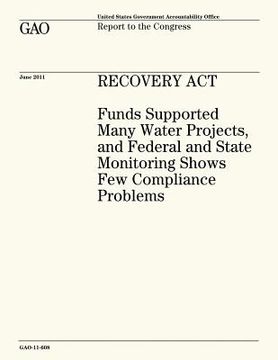Recovery Act: Funds Supported Many Water Projects, and Federal and State Monitoring Shows Few Compliance Problems (en Inglés)
Reseña del libro "Recovery Act: Funds Supported Many Water Projects, and Federal and State Monitoring Shows Few Compliance Problems (en Inglés)"
The American Recovery and Reinvestment Act of 2009 (Recovery Act) provided $4 billion for the Environmental Protection Agency's (EPA) Clean Water State Revolving Fund (SRF) and $2 billion for the agency's Drinking Water SRF. The Recovery Act requires GAO to review funds made available under the act and comment on recipients' reports of jobs created and retained. GAO examined the (1) status and use of Recovery Act SRF program funds nationwide and in nine states; (2) EPA and state actions to monitor the act's SRF program funds; (3) EPA and selected states' approaches to ensure data quality, including for jobs reported by recipients of the act's funds; and (4) challenges, if any, that states have faced in implementing the act's requirements. For this work, GAO, among other things, obtained and analyzed EPA nationwide data on the status of Recovery Act clean and drinking water funds and projects and information from a nonprobability sample of nine states that represent all but 1 of EPA's 10 regions. GAO also interviewed EPA and state officials on their experiences with the Recovery Act SRF program funds. The 50 states have awarded and obligated the almost $6 billion in Clean Water and Drinking Water SRF program funds provided under the Recovery Act, and EPA indicated that all 50 states met the act's requirement to award funds to projects under contract 1 year after the act's passage. States used the funds to support more than 3,000 water quality projects, and according to EPA data, the majority of the funds were used for sewage treatment infrastructure and drinking water treatment and distribution systems. Since the act was passed, states have drawn down almost 80 percent of the SRF program funds provided under the act. According to EPA data, states met the act's requirements that at least (1) 20 percent of the funds be used to support "green" projects and (2) 50 percent of the funds be provided as additional subsidies. In the nine states GAO reviewed, the act's funds paid for 419 infrastructure projects that helped address major water quality problems, but state officials said in some cases the act's requirements changed their priorities for ranking projects or the projects selected. In addition, although not required by the act, the nine states used about a quarter of the funds they received to pay for projects in economically disadvantaged communities, most in additional subsidies. EPA, states, and state or private auditors took actions to monitor Recovery Act SRF program funds. Also, in part as a response to a GAO recommendation, in June 2010 EPA updated--and is largely following--its oversight plan, which describes monitoring actions for the SRF programs. Furthermore, state officials visited sites to monitor Recovery Act projects, as indicated in the plan, and found few problems. Officials at EPA and in the nine states have also regularly checked the quality of data on Recovery.gov and stated that the quality has remained relatively stable, although GAO identified minor inconsistencies in the FTE data that states reported. Overall, the 50 states reported that the Recovery Act SRF programs funded an increasing number of FTE positions for the quarter ending December 2009 through the quarter ending June 2010, from about 6,000 FTEs to 15,000 FTEs. As projects were completed and funds spent, these FTEs had declined to about 6,000 FTEs for the quarter ending March 2011. Some state officials GAO interviewed identified challenges in implementing the Recovery Act's Clean and Drinking Water SRF requirements for green projects and additional subsidies, both of which were continued with some variation, in the fiscal year 2010 and 2011 appropriations for the SRF programs. Officials in four states said achieving the green-funding goal was difficult, with one suggesting that the 20 percent target be changed.

